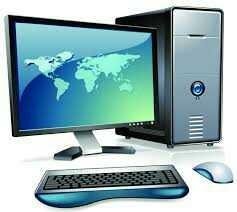Computer history
This time I will share a small note about computers and their history in everyday life even though we use computers even though they are often or rarely but we don't know the history and the way computers work.
Computer History.
Who doesn't know computers? I think almost everyone has known and is familiar with this sophisticated tool. Almost in every school, offices and even houses we can meet with tools called computers. But do you know about the history of origin from a computer. What is the history of computer development from time to time. Of course there are still many people who are unfamiliar about computer history. Here I will discuss the history of computer development from the first generation to the fifth generation,
Along with the times, until now the development of computers is unstoppable. The computer itself has a definition of a tool that consists of input devices, process tools and output tools that work according to orders for specific purposes.
According to several sources, the computer was first created by a person named Charles Babbage. Starting from his discovery, he created a simple calculating device which was the forerunner of the existence of computers until now. Thanks to these discoveries, making Charles Babbage became a very influential person in the history of computer development.
From these findings, Charles Babbage gave the name of the device Difference Engine no. 1. Difference Engine no. 1 is the first automatic calculator that facilitates the calculation work. At that time, Charles Babbage's discovery was a phenomenal discovery in the world that had a major influence on the history of computer development until now. For his discovery Charles was crowned as the Father of the Computer or the person who invented the computer.
Early History of Computers
Based on the history of its development, computers are divided into five generations. For more details, please refer to the explanation of the five generations of the computer.
First Generation Computer
On the first generation computer named ENIAC. ISIAC stands for Electronic Numerical Integrator and Computer. ENIAC is the first computer created in the world. This computer weighs approximately 30 tons, 30 meters long and 2.4 meters high. While the electrical power needed by this computer is 174 kilowatts. This first generation computer consists of 18,000 vacuum tubes, 70,000 resistors and 5 million soldering points.
Second Generation Computer
In 1948, the invention of the transistor affected the development of computers. With the invention of this transistor replaced the role of vacuum tubes on television, radio and computers. So that the size of electronic devices is drastically reduced.
The use of transistors in a computer began in 1956. Another discovery in the form of magnetic core memory, helped the development of second generation computers have a smaller size, faster, more energy efficient and more reliable than the first generation of computer first.
The first machine that utilizes this new technology is a supercomputer. On second generation computers no longer use machine language but is replaced with assembly language. Assembly language is a language consisting of abbreviations to replace binary code.
In the early 1960s, second generation computers began to emerge and were widely used in business, university and government. On second generation computers fully use transistors. The components that can be associated with computers at this time such as printers, data storage in diskettes, memory, operating systems and application programs.
Third Generation Computers
In the previous generation, almost all computers used transistors. The use of transistors is indeed able to outperform vacuum tubes, but the use of transistors can produce a large enough heat, so that it has the potential to damage computer parts.
In 1958, Jack Kilby, an engineer at Texas Instruments, developed an integrated circuit (IC). The IC combines three electronic components in a small silicon dish made of quartz sand. Development of ICs made of quartz sand is able to deal with hot temperatures.
The scientists then managed to put more components into a single chip called a semiconductor. The results of the findings of these scientists make the size of the computer smaller because the components can be compacted into a chip.
Another progress of third generation computers is in the use of the operating system or operating system. That allows the machine to work on different programs at the same time as a main program that is responsible for monitoring and coordinating computer memory.
